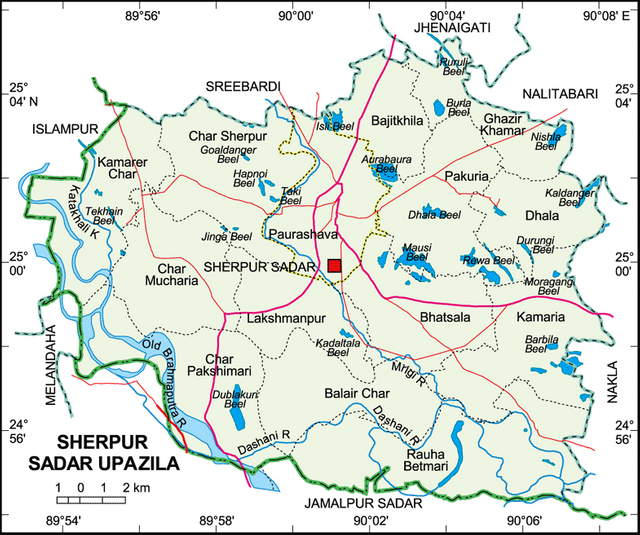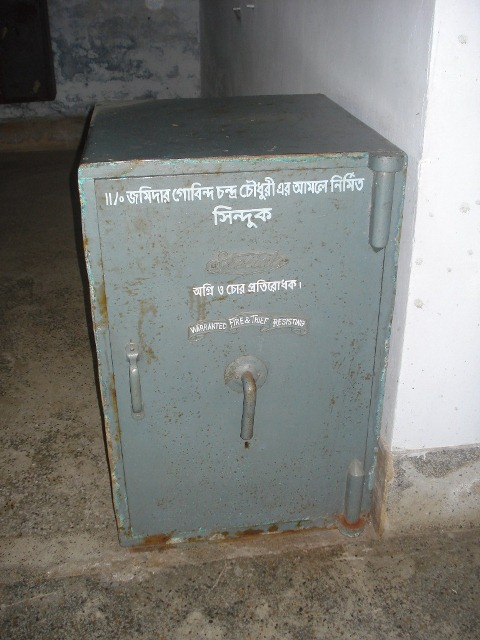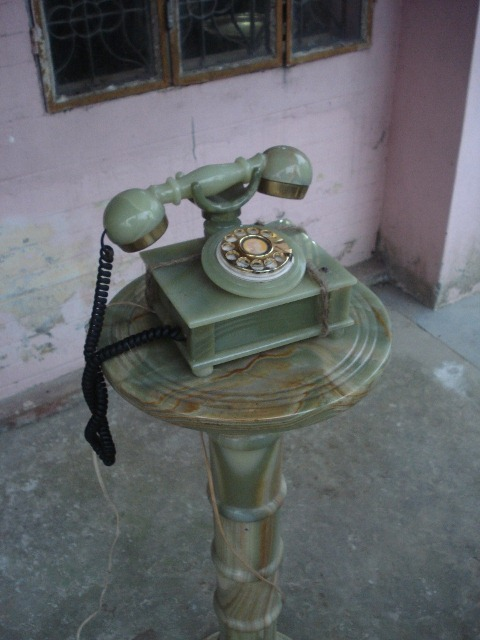Our Sherpur District
Sherpur region was a part of the kingdom of Kamrupa in ancient times. During the reign of Mughal emperor Akbar, this area was known as "Dahkahinya Baju". Before going to Sherpur, the Brahmaputra river had to pass through the river. Ten months ago, the area was known as Dasakahania because the decade was determined for ferry crossing. In the beginning of the seventeenth century, Ghawai of Bhawal, occupied tenkahania areas from the descendants of Isa Khan. It was later named as Sherpur after the name of Sher Ali Ghazi, the last landlord of Gazi dynasty. During the Karnawalis from Warren Hastings, the Fakir-Sannyasi rebellion was held against the East India Company and the local zamindars; Tipu Shah, leader of the Fakir movement, declared sovereignty in this area and established his capital at Hazratpuri. Farmer's conference was held in 1906, 1914 and 1917 in Sherpur's Kamar Char Char under the leadership of Khush Muhammad Chowdhury. In 1838-48 communists rebelled against Sherpur in protest against the Nankar, Tank, Bawali, Mahajani, Izaradari system. In 1897 a devastating earthquake changed the direction of the Brahmaputra to the west and forced it to merge with Jamuna; It also causes serious damage to many ancient buildings.In British period and during the Pakistan period, its name was Sherpur Circle. During the zamindari period, Sherpur Municipality was established in 1869. After the independence of Bangladesh, Father of the Nation Bangabandhu Sheikh Mujibur Rahman declared Sherpur as the 61st District. But this decision was postponed by changing political parties. In 1979 Sherpur was subdivision and Sherpur was promoted to the district in 1979 and five thanas of the district were turned into upazilas.

Sherpur district's total border road is 50 km. Of these, 42 km of the administrative divisions of Sherpur and 8 km of Jamalpur division of the road and public section. Meanwhile, the approval for the development project of 2865 crore has been approved and the work of renovation of the renovated-Netrokona-Mymensingh-Sherpur-Jamalpur 80km road is underway. The development of the thana was turned into an upazila.
Sherpur was under Sector 11. Sherpur became independent on 7th December 1971. Captain Jagjit Singh Arora landed in the helicopter Daroka Ali Park in the city and officially hoisted the national flag of Bangladesh.
Mass killing site: Ahmednagar (Jhenyigati), Jhawgara (Sherpur), Widow village (Sohagpur, Nalitabari), Qari Road (Jhenaigati) witnessed the liberation war of this district.
People of small ethnic groups like Coach, Garo, Hajong, Dalu, Banai and Rajbangshi etc. have lived for hundreds of years in the Karo Hills of the northern border of present-day Sherpur and its surrounding areas. These small ethnic groups speak their own language.
Economy:
Sherpur's economy is mainly agrarian, though non-agricultural economic activity plays an important role in the development activities of the district. Among the total 3,35,460 homesteads in the district, 60.12% of the farm which produces various crops like local and high yielding rice, wheat, jute, mustard, potato, pulses, various vegetables, tobacco and others. Various fruits of banana, mango, coconut, betel nut, date palms, jackfruit, rhythm, grapefruit, bell, papaya, belli, kamranga, atafal etc are cultivated. Like many other parts of the country, different varieties of fish are also available in this district. Different types of fish, tributary channels and inlet are fished. Popular fish are rui, katla, mrigel, kalbaus, chital, boal, aad, pangas, shrimp, shol, pabda, koi, horn, thong, sandy, tengra etc. Also, the newly known foreign fish are Tilapia, Nilotika, Silver Carp, Grass Carp etc. Also the main source of income for crops, livestock and fisheries. Non-agricultural activities also play an important role in the economy of the district. This field is largely dependent on rice stalks. Along with the creation of a large number of jobs, along with the help of small and medium enterprises such as powdered, husk, they are helping to become customers.
Tourist places:
Ghazni Vacation Center
Madhutila Echopark (Nalitabari)
Sher Ali Ghazi's shrine
Surveying Shah's shrine
Shah Kamal's Mazar (1644 AD)
Bar Dwari Mosque
Ghagra Laskar Khan Mosque
Mysahba Jame Mosque
Water Hata Dighi
Nayani Bazar Nat Mandir
Temple of Raghunath Jyu
Gangaripa Kalidha Gang's Dingle
The famous Rubberdam of Nalitabari
Math Laskar Bari Mosque (1808 AD)
Gargaripa Fort (1486-91 AD)
Kasba Mughal Mosque
I do not have two and a half ani and three ani zamindars in my life
Durga of Miracle Gazi - RuniGao, Nokla
Munshi Dada Mazar - Nayabari, Birbhichar, Nokla.
Eminent personality:
Sher Ali Ghazi;
Afsar Ali - leader of the anti-British movement;
Ravi Negi - Revolutionary;
Matia Chowdhury - Agriculture Minister
Khandaker Abdul Hamid - State Minister
Md. Mahbubul Alam Shaheen - medical technician
District traditions:
Ghagra Khan House Mosque: Construction is approximately 600 years ago. It is said that the 'Khana Kha' and 'Jabbar Kha' were commanders of one of the two senodors. After defeating, the brothers took refuge in this forest and established this mosque there. The specialty of the mosque is that its bricks are like a four-sided tali. These bricks were used six to seven hundred years ago today. Used in stove, jute or fiber-fiber with pistachios or pistachios powdered or loincloth. The construction technique of the one-domed mosque reflects the reflection of the Greek and Korean Théan styles. It is easy to assume that at the entrance of Arabic language construction and identity rock inscription, the skilled architect was also in this region. The mosque is a unique architecture of ancient history. Seeing which any tourist will be attracted, be seduced.
Mai Saheba Mosque: 250 years before construction date This is also one of the ancient patterns of this district. At present, the mosque has been rebuilt in modern form. The use of the archers archers and the high mina 2 are truly sighted. Modern mosque has been noticed in modern mosque. It is situated on the south-western side of Sherpur Government College in the heart of Sherpur city. During the entry of Sherpur, the minarets are seen from a distance. There are lots of places in front of the huge mosque. Eid congregations are held here every year. After entering the city of Sherpur, this mosque will look at anyone.
Gharjaripa Bar Dwari Mosque: One of the highest average surveys of architectural times is the Dwari Mosque. This is also the tradition of the region. This mosque was originally built by Suraj Shah, a Muslim ruler, about 7-8 hundred years ago. However, it has been rebuilt. The original mosque remains in the womb. The current mosque was founded on it. A Pir Azizul Haque Shereb, performing the excavation work at village Pingalhati (Kutubnagar) of Jamalpur Sadar upazila (north of Brahmin Jee Billy).
Short Description of Survival:

The Ark built during the reign of Zamindar Govinda Chandra Chowdhury
![image.png]Shajgarh built during the zamindar period

Far away
i follow you! like this post.
Please, Follow me too.
Thank you and upvote.